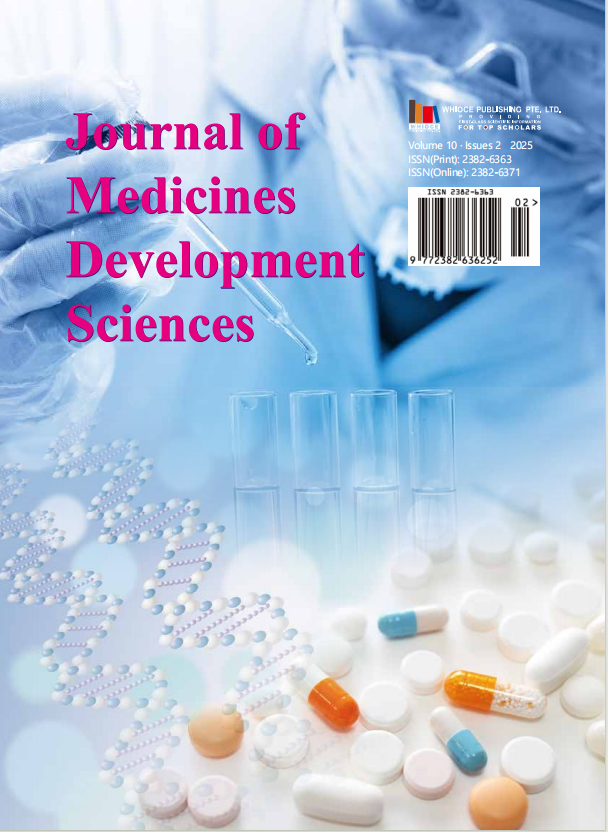Innovative Technologies and Quality Evaluation of Oral Sustained-Release and Controlled-Release Preparations
DOI:
https://doi.org/10.18063/jmds.v10i2.783Keywords:
Oral sustained-release and controlled-release preparations, Innovative technologies, Quality evaluation, Drug release, BioequivalenceAbstract
This paper systematically explores the innovative technologies and quality evaluation system of oral sustained-release and controlled-release preparations. By combing the principles and limitations of traditional preparation technologies, it focuses on expounding novel innovative technologies such as ion-exchange resin, microsphere, and 3D printing, along with their application examples, and analyzes the advantages and disadvantages of each technology in drug release control. Meanwhile, it elaborates on the principles and applications of quality evaluation methods, including in vitro release rate test, in vivo bioavailability and bioequivalence evaluation, and in vitro-in vivo correlation evaluation, and illustrates the importance of quality evaluation in the research, development, and quality control of preparations through specific cases. In addition, it discusses the impact of innovative technologies on quality evaluation and proposes strategies for balancing innovation and quality control. The research shows that innovative technologies drive the development of oral sustained-release and controlled-release preparations, and a scientific quality evaluation system is crucial for ensuring the safety and effectiveness of preparations. The coordinated development of these two aspects helps to enhance the clinical application value of preparations.
References
Ahmed N, Ly H, Pan A, et al., 2023, Retrospective Analysis of the Biopharmaceutics Characteristics of Solid Oral Modified-Release Drug Products in Approved US FDA NDAs Designated as Extended-Release or Delayed-Release Formulations. European Journal of Pharmaceutics and Biopharmaceutics, 193: 294–305.
Sabzevari AG, Sabahi H, Nikbakht M, et al., 2022, Development and Characteristics of Layered EGCG/Montmorillonite Hybrid: An Oral Controlled-Release Formulation of EGCG. Journal of Drug Delivery Science and Technology, 76: 103750
Vydana R, Bonnoth KSC, Suryadevara V, et al., 2021, Preparation and Evaluation of Captopril Oral Floating Controlled Release Formulations. Journal of Pharmaceutical Research International, 2021: 442–452.
Kerry R, Malik DJ, 2021, Microencapsulation of Bacteriophages Using Membrane Emulsification in Different pH-Triggered Controlled Release Formulations for Oral Administration. Pharmaceuticals, 14(5): 424–424.
USPTO, 2017, Patent Application Titled "Methods of Preparing Oral Controlled Release Formulations". Journal of Engineering, (Patent No.: 20170079921).
Alicia D, Alejandro P, Natasha E, et al., 2015, Pharmacokinetic Assessment of Novel Controlled Release Formulations of Ricobendazole Intended for Oral Administration in Dogs. Journal of Clinical and Experimental Pharmacology, 5(6): 1–8.
Ganesan P, Ramadass J, Johnson AJD et al, 2015, Preparation and Characterization of Chemical Cross-Linked Oral Controlled Release of Atorvastatin Calcium Loaded Ethyl Cellulose Microsphere. Advanced Science, Engineering and Medicine, 7(11): 980–989.
Olivares-Morales A, Kamiyama Y, Darwich SA, et al, 2015, Analysis of the Impact of Controlled Release Formulations on Oral Drug Absorption, Gut Wall Metabolism and Relative Bioavailability of CYP3A Substrates Using a Physiologically-Based Pharmacokinetic Model. European Journal of Pharmaceutical Sciences, 67: 32–44.
Ramchandani KL, Joshi JD, Lalwani AN, et al., 2012, Preparation and Development of Oral Controlled Release w/o/w Multiple Emulsion of Carbamazepine. Drug Delivery Letters, 2(3): 213–222.
Iwanaga K, Kawai M, Miyazaki M, et al, 2012, Application of Organogels as Oral Controlled Release Formulations of Hydrophilic Drugs. International Journal of Pharmaceutics, 436(1–2): 869–872.

